

Sparking Outside-In Thinking in the Spirit of Healthy Accountability
Paul Batz
A CEO of a leading physician-led firm said to me, “We only get along when our swords are pointed out.”
What does that mean? It means that the business of healthcare is a daily battle. And highly independent, powerful people only get along when their swords are turned toward the marketplace, not at one another. When the swords are “pointed out” they have each other’s backs and are willing to fight for what they believe in. This is what we mean by “outside-in” thinking. The team isn’t functional when they are pointing their swords at each other, that’s “inside-out” thinking.
The outside-in vs. inside-out concept was important in this story, because the CEO’s team was stuck for a while. Nobody was excited about the direction of the organization – because all their goals were inside-out focused. There was daily in-fighting and very little collaboration – they were forgetting the big picture, while everyone was protecting their own part of the business. They were “pointing their swords at each other.”
Why is healthy accountability so important for outside-in thinking?
Human beings are drawn to “the tyranny of today,” willing to stop what they are doing to help someone who has a problem. And, we love the short-term satisfaction of stamping out fires and relieving the daily pains our employees bring us. But the more the leaders at the top are involved in the tyranny of today, the less likely the business is to run with an “outside-in” mentality. In an organization where healthy accountability exists, executives aren’t pulled down in the day-to-day firefighting; employees seek accountability rather than waiting to be held accountable.
Healthy accountability allows top leaders to focus on winning against competitors with an outside-in perspective. When everyone in the organization embraces outside-in thinking, healthy accountability thrives because their actions are directly tied to the organizations success in the marketplace.
Sparking the mindset shift
Here’s the simplest equation I learned from my business mentors:

- Inside-out thinking = slow decay, decline and inertia
- Outside-in thinking = growth, competitiveness and positive momentum
The discussion with the physician-led executive team that turned the tide involved two polarities:
- What are we building that is special: to each other, our owners, and our customers?
- What is our most credible threat we need to fight, that would hurt what we are building?
Both of those questions are “outside-in” and they bring out the competitive juices in executives.
So, how are you sparking Outside-In thinking?



